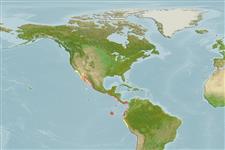Common names from other countries
>
Carangaria/misc (Various families in series Carangaria) >
Polynemidae (Threadfins)
Etymology: Polydactylus: Greek, poly = a lot of + greek, daktylos = finger (Ref. 45335).
More on authors: Lay & Bennett.
Environment: milieu / climate zone / depth range / distribution range
экология
морской; солоноватоводный демерсальный; пределы глубины 10 - 60 m (Ref. 91172). Subtropical; 37°N - 12°S, 122°W - 77°W (Ref. 57343)
Eastern Pacific: Monterey Bay, California, USA to Callao, Peru. One record from the Galapagos Islands. Rare north of Baja California, Mexico (Ref. 2850). Record from Chile (Ref. 9068) needs to be verified (Ref. 57343).
Size / Вес / Возраст
Maturity: Lm ? range ? - ? cm
Max length : 36.8 cm TL самец/пол неопределен; (Ref. 115882); common length : 20.0 cm TL самец/пол неопределен; (Ref. 55763)
колючие лучи спинного плавника (общее число) : 9; членистые (мягкие) лучи спинного плавника (общее число) : 11 - 13; колючие лучи анального плавника: 3; членистые (мягкие) лучи анального плавника: 13 - 15; позвонки: 24. Body grayish, no stripes or spots. Lip on lower jaw well developed. Dentary teeth restricted to dorsal surface. Maxilla not covered with scales. Pectoral filaments 6; longest not reaching beyond level of posterior end of anal fin base. Lateral line bifurcated on caudal fin membranes, extending to posterior margins of upper and lower caudal fin lobes. Swim bladder present (Ref. 45049).
Found in shallow water near the coast, on sand and mud bottoms (Ref. 9332). Larvae and small juveniles (>4 cm) are pelagic and sometimes occur several hundred kilometers offshore, whereas the larger juveniles and adults prefer shallow near-shore waters like bays, sloughs or estuaries where the bottom is sandy or muddy (Ref. 28023). Omnivorous, feeds on worms, sand crabs, shrimp, clams; sometimes feeds on fish like small anchovy (Ref. 28023). Esteemed food fish where it occurs (Ref. 57343). Also Ref. 55763.
Life cycle and mating behavior
Maturities | размножение | Spawnings | Egg(s) | Fecundities | личинки
Motomura, H., 2004. Threadfins of the world (Family Polynemidae). An annotated and illustrated catalogue of polynemid species known to date. FAO Spec. Cat. Fish. Purp. Rome: FAO. 3:117 p. (Ref. 57343)
Статус Красного Списка МСОП (Ref. 130435)
CITES (Ref. 128078)
Not Evaluated
Угроза для людей
Harmless
Использование человеком
рыболовство: коммерческий
дополнительная информация
инструменты
Специальные отчеты
Скачать в формате XML
ресурсы в Интернет
Estimates based on models
Preferred temperature (Ref.
115969): 20.5 - 29, mean 25.9 (based on 273 cells).
Phylogenetic diversity index (Ref.
82804): PD
50 = 0.5000 [Uniqueness, from 0.5 = low to 2.0 = high].
Bayesian length-weight: a=0.00646 (0.00433 - 0.00962), b=3.06 (2.94 - 3.18), in cm Total Length, based on LWR estimates for this species & Genus-body shape (Ref.
93245).
Trophic level (Ref.
69278): 3.6 ±0.6 se; based on diet studies.
устойчивость к внешним воздействиям (Ref.
120179): высокий, минимальное время удвоения популяции до 15 месяцев (Preliminary K or Fecundity.).
Fishing Vulnerability (Ref.
59153): Low to moderate vulnerability (27 of 100).
